Source: Bai Ze Research Institute
There is not much content about the new narrative Web3 x Agent in China. It is an honor to cooperate with HajimeAI, a potential AI project on Solana, to complete this research.
Looking back to January this year, the approval of Bitcoin spot ETFs in the United States triggered strong bullish sentiment and positive capital inflows among investors. The crypto market continued to grow in the first half of 2024, with a total market value increase of 37.3%. Several Crypto narratives have gained strong momentum. In my impression, Memecoin, AI, and RWA are the strongest performers. Judging from the performance of the currency price last week, AI is still relatively strong, second only to Memecoin.

Web3 x AI, this year, various Web3 VCs have made huge bets on this track, and can even buy old projects TAO (Bittensor) on the open market, so I don’t think this is a fleeting narrative. On the contrary, it will continue to innovate as the traditional AI track develops.
For example, AI Agent, the latest trend in the traditional AI field, has also been brought into the Web3 world. In the first half of the year, a large number of Web3 x AI Agent projects were launched, such as Spectral and Olas Network, and many old projects are also following this narrative, such as Fetch.AI $FET, Phala $PHA. At the just-concluded ETHCC, many Web3 developers and top VCs began to focus on the AI Agent narrative.
This article starts with what I think are the two most representative new projects to quickly understand this new narrative and the opportunities therein.
Contents:
1. What is AI Agent?
2. New changes in Web3 x AI Agent
3. Spectral investment research
4. GaiaNet investment research
5. Overview of other early projects
1. What is AI Agent
In simple terms, AI Agent is an "agent" based on a large language model (LLM) that can perceive the environment for autonomous understanding, independent thinking, autonomous decision-making, and execution of actions. Similar to the process of "doing things" by humans, the core functions of Agent can be summarized into three steps: perception, planning, and action.
So how is AI Agent different from AI chatbots such as ChatGPT? In terms of purpose and ability
Chatbots are designed to interact with humans. Since AI chatbots are designed to help humans, they will not take autonomous actions;
Agents are designed to complete autonomous tasks and have the ability to take autonomous actions. You don't have to tell it what to do all the time. Just give it a goal and it will find a way to automatically help you complete it.
For example, AI Agent is like a smarter Xiao Ai. When you are sick, you say to it: "Xiao Ai, I feel a little uncomfortable."
It will monitor your body temperature and other physical indicators, and combine the data and information on the Internet. After analysis, it will give you a conclusion: "You are positive." Then it will actively generate a leave note for you, and you just need to nod to send it directly to your boss. And it can also sense that the antipyretic medicine at home is not enough, so it will help you add the medicine to the shopping cart. As long as you pay, it will be delivered to your door in 15 minutes.
I have used almost all of the most popular AI Agents in Web2, such as Perplexity, CrewAI, AutoGPT, and MultiOn. The more commonly used functions include batch document content extraction and Internet information integration (generating research reports). I have enjoyed using MultiOn, a product that I would like to introduce in detail. Its main function is to simplify Internet user interaction, free up users' hands, and change the interaction mode between users and the Internet.
For example, I gave MultiOn a task, "Help me find the most played Web3-themed videos on Youtube", and all the steps from "open Youtube in the browser", "search for the theme of Web3", and "filter the most played videos" were completed automatically. Finally, the Agent outputted me a video with 26 million views.
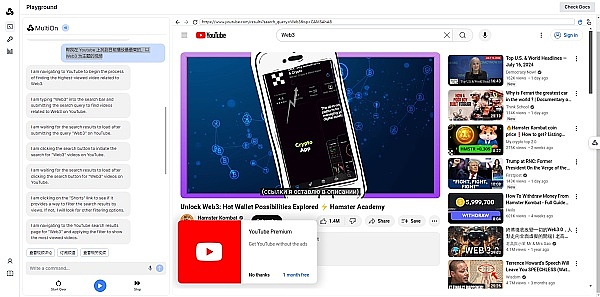
New changes in Web3 x AI Agent
First of all, what can Web3 bring to AI Agent? In other words, what are the benefits of moving AI Agent to the chain?
AI Agent is based on LLM. Centralized LLM will lead to output biased towards censored results, which will limit the spread of real information to a certain extent. Using decentralized LLM to build AI Agent can solve this problem.
By the same token, unless you spend a huge amount of data resources to do LLM, the core data of AI Agent is still stored in the centralized AI provider.
AI Agent Launchpad? Issuing coins to govern a certain AI Agent, IAO (Initial Agent Offering), provides a disguised way for AI Agent developers and investors.
Interoperability between AI Agent and other Agents on the same network in terms of interaction, transaction, and empowerment. If we refer to the composability of DeFi, it will not be surprising that in the future, only one Web3 AI Agent will be used to select investment products, find the most liquid DEX, complete token exchange, and monitor income.
In turn, what can AI Agent bring to Web3?
1. Conversational AI Agent on-chain, in addition to the collection and organization of specific field expertise that Web2 Agent can do, can also retrieve and summarize information on the Web3 chain, greatly simplifying the process of Web3 user chain research.
2. Just looking at the concept of AI Agent, and MultiOn, it really reminds me of the Intent-Centric (intention-centered) that I have been teasing. What needs to be done is to liberate the hands of users on the chain, change the way they interact with Web3, and realize Mass Adoption. These interactions include but are not limited to Swap and airdrop interactions. Imagine saying to AI Agent, "Help me complete the Linea airdrop interaction", AI Agent can get the airdrop tutorials of KOLs from the Internet, and then automatically complete it through the on-chain wallet following the steps. (Then it seems that there is no need for LuMao Studio?)
Or "Help me build an ETHBot. When ETH is lower than MA200, use 30% of my USDT balance to buy ETH", monitoring the market around the clock, isn't it sexy.
If each solver uses an AI Agent that can automatically interact on the chain, it actually realizes the most important piece of the puzzle of the intent protocol.
For Intent-Centric, you can check my previous WeChat article.
So here, I would like to divide the current Web3 x AI Agent track into two specific products, one is the Web2-style on-chain dialogue AI Agent, and the other is the more Web3 Native AI Agent mentioned in the previous paragraph.
The first can be understood as an AI Agent created on a certain Layer-1, which is suitable for Web3 users to learn professional knowledge in a specific field and do on-chain research. Does not include on-chain operations
The second type can be understood as logic on-chain, helping users to achieve some specific interactions on the chain. Includes on-chain operations
Of course, my classification is only the most basic based on "whether the AI Agent has the ability to interact on the chain", and does not consider whether it is based on a reliable and verifiable decentralized AI model.
Below, we introduce a typical project, GaiaNet and Spectral, for horizontal comparison
Three, Spectral (with on-chain operation capabilities)
The predecessor is an Ethereum-based credit scoring protocol that aims to provide lenders with a new way to assess the credit risk of borrowers.
2023 Q4 Transformed into a machine intelligence network, allowing users to build on-chain AI Agents and form an on-chain agent economy.
1. Business Model
Spectral has four important products:
Spectral Syntax, an officially developed collection of Agents, where users can tell an Agent what to do, and the Agent will convert natural language intent into executable code to help users complete it. For example, creating NFTs, creating Memecoins, automating transactions, and retrieving information on the chain. I personally experienced MoonMaker Agent, which can automate everything from name creation, logo design to CA deployment.
Spectral Nova, a decentralized platform that directly provides machine learning reasoning to smart contracts, where model creators such as top scientists, enterprises, Dev, and engineers can build AI models and obtain user paid income. In addition, model creators can issue challenges with rewards. Solvers (bounty hunters) solve challenges, win rewards, or receive revenue dividends. Creators, solvers, verifiers, and consumers interact with each other on Spectral's machine intelligence network, forming a flywheel through incentive mechanisms.
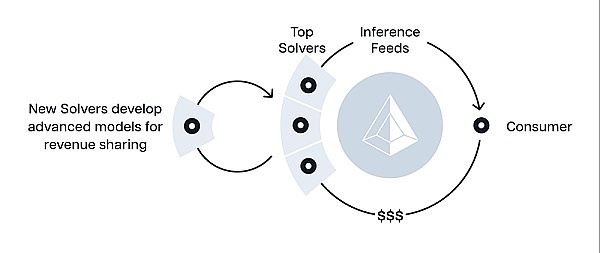
Agent Wallets, launched in Q3 2024, will help users implement on-chain operations and simplify the Web3 user experience by integrating AI Agents into wallets. For example, it supports gas-free transactions using USDC, and the Gas Asset Agent will automatically perform the exchange.
Inferchain, a Layer1 with AI Agent as the narrative, will integrate Agents in Syntax and Nova to promote interoperability between these Agents. It will be launched in Q4 2024.
2. Development History
2021-2022 Completed financing as Web3 credit risk assessment infrastructure
2024.03 Launched Syntax, officially transformed into an on-chain AI Agent narrative
2024.05 TGE, launched the first quarter airdrop
2024.06 Cooperated with the crypto wallet Turnkey, and launched Agent Wallet in Q3 (Turnkey once raised US$15 million, with Sequoia and Coinbase participating)
3. The intersection of AI x Web3
Inferchain is the last piece of the puzzle for Spectral's ecosystem, realizing its ultimate vision, easily developing on-chain AI Agents, and enabling them to communicate with each other, and ultimately making AI applications in the Web3 field transparent, decentralized, and verifiable.
4. Value generated
It solves the problems of expensive trial and error of centralized AI, reliance on a single source and information authenticity;
It enables ordinary users (non-technical) to quickly create on-chain agents;
It promotes communication between on-chain agents.
5. Token economics
$SPEC, users can use tokens as a means of payment to pay for the use of community-developed AI Agents. In addition, it is also used for decentralized governance and staking mechanisms:
In Spectral Syntax, users who stake SPEC have the right to create AI Agents and access AI Agents created by the community;
In Spectral Nova, validators need to stake SPEC as collateral to verify the challenges completed by solvers.
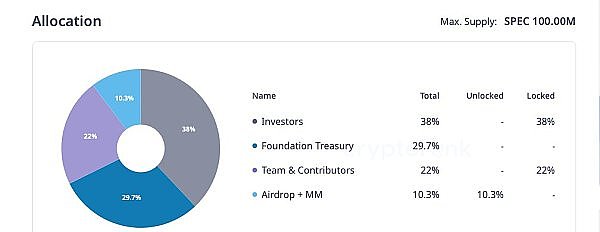
SPEC has been listed on Bybit, Gate.io, MEXC and other trading platforms, with a circulating market value of 85 million US dollars and a FDV of 800 million US dollars
Currently, the circulating part is only the first quarter airdrop + market maker share, accounting for 10.3% of the total
2025.05 will start unlocking for core contributors and investors. If the crypto market continues to rise in the next few months of this year, you need to pay attention to the risk of selling after unlocking
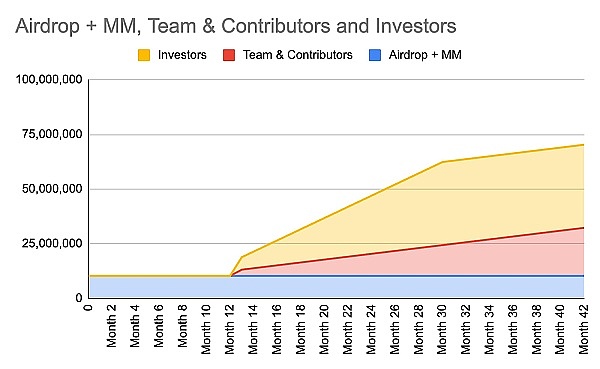
6. Team Background
Sishir Varghese - Co-founder and CEO
Previously served as co-founder and managing partner of AlphaChain, and also served as a strategic partner of Loopring
Mihir Kulkarni - Product Director
Previously was an institutional product operations manager at Coinbase
7. Financing
Round 1:
Galaxy, ParaFi Capital, Maven 11, Alliance DAO, Rarestone Capital …
Round 2:
General Catalyst, Social Capital, Jump Capital, Samsung Next, Circle Ventures, Franklin Templeton, Section 32 …
Super large VC Investment background, such as Franklin Hampton, Samsung, Google
8. AI Agent Usage
Q2 data released in June 2024:
Registered users 65,362
Number of contracts generated by SYNTAX 1,055,568
Average number of interactions per user 25
Number of Memecoins created using MoonMaker 5,043
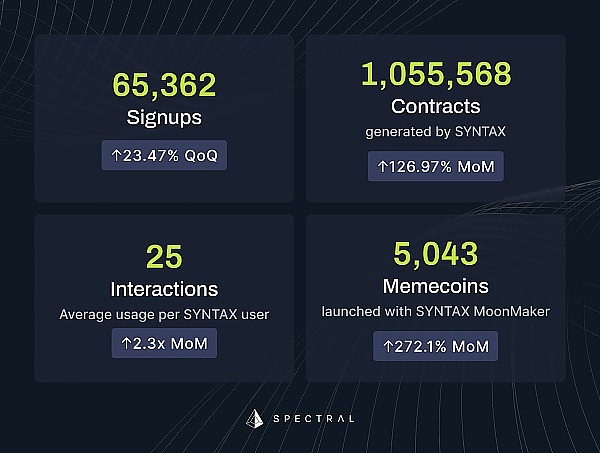
Fourth, GaiaNet (no on-chain operation capabilities)
GaiaNet It is a distributed AI infrastructure that will gradually become a decentralized AI Agent ecosystem
1. Business model
Node = Agent. In my own practice of building nodes, when I talk to the AI Agent corresponding to the node, the output of the AI Agent consumes computing resources.
Build an AI Agent network based on Ethereum that aggregates knowledge bases in various fields in the form of nodes, allowing individuals and enterprises to quickly build AI Agents based on their own expertise in specific fields and provide them to the demand side for profit.
Three core components of the GaiaNet network:
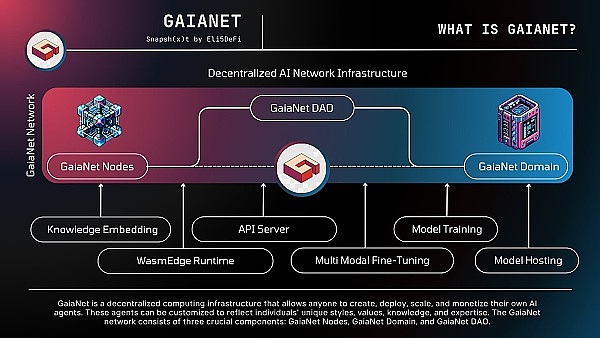
• GaiaNet Node
A comprehensive software stack that enables individuals and enterprises to quickly deploy AI Agents that incorporate their own expertise.
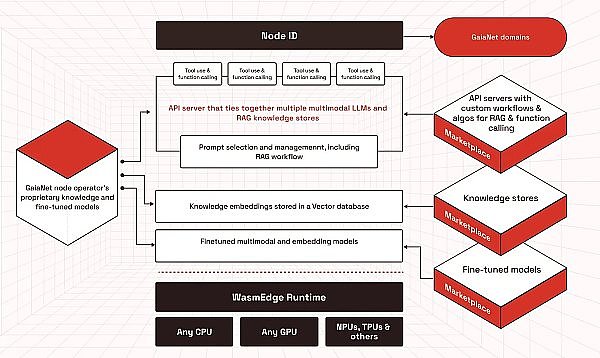
• GaiaNet Domain Name
A collection of nodes registered under an Internet domain name, managed by a domain name operator. The official idea is that each domain name is specific to a professional field, such as finance, medical care, and education, and under these domain names are AI Agents with specific functions.
User Usage Process:
Users pay the node (AI Agent), and the fee is hosted in the on-chain smart contract. Part of the fee is taken by the domain name operator, and then the service is provided to the user.
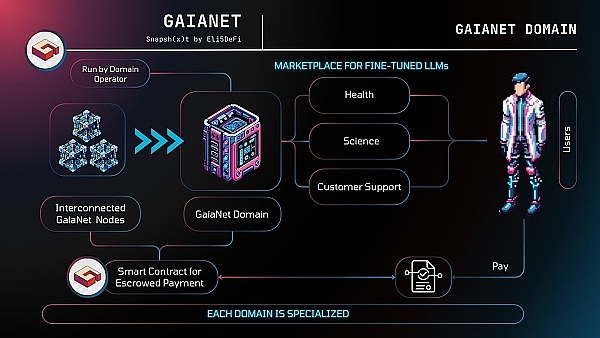
• GaiaNet DAO
Stakers stake tokens on domain name providers to provide "trust";
Domain name providers manage qualified nodes and provide "guarantees";
Users choose to use the AI Agent under the domain name provider, and the fees are divided among the nodes, domain name providers, and Stakers.
In fact, there is another role of component developers. Non-AI Agent developers can obtain benefits from AI Agent developers in need by fine-tuning NFT-style models, knowledge bases, plug-ins and other components.
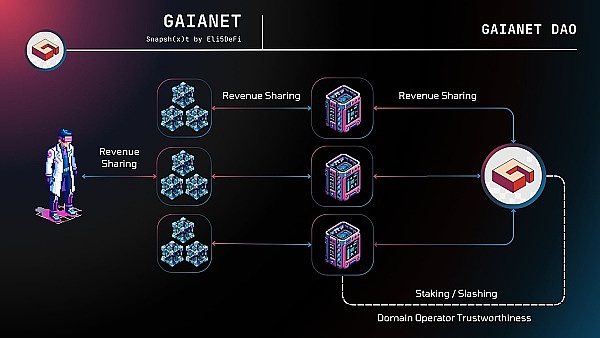
2. AI x Web3 integration
Moving the Web2 AI Agent ecosystem to the chain
3. Generated value
Developers can deploy Agents more easily. Gaianet nodes support all open source LLMs, multimodal models, text-to-image models, and text-to-video models. You can add and fine-tune the model according to your choice.
Based on the domain name provider, a collection of AI Agents with professional knowledge will be generated for each industry and each field.
4. Token Economics
No tokens have been issued, and tokens are paid using other people's Agents in GaiaNet
5. Team Background
Matt Wright - Co-founder and CEO
Graduated from UCLA, previously served as the community director of Consensys and co-founder of EVM Capital. Worked at JP morgan.
Shashank Sripada - Co-founder
Background in venture capital in Web2, founded and joined several VCs. Graduated from the London School of Economics and Political Science, with some political background.
Sydney Lai - Head of Development and Publicity
Co-founder and CTO of EVM Capital, graduated from the University of California, Berkeley
6. Financing
2024.05.28, seed round, $10 million
Mantle Network, ByteTrade, EVM Capital, Mirana, Lex Sokolin (Co-founder of Generative Venturesc), Kishore Bhatia (founding member of Superscryptc), Brian Johnson (encryption director of Republic Capital)
7. AI Agent usage
The number of users is unknown, there are only 35 conversational AI agents available, and their knowledge covers finance, Crypto, programming and other fields. The total number of nodes at present: 18,594
Since it is in the testing phase and can run nodes in multiple threads, it is speculated that the nodes that are airdropped in batches account for the majority.
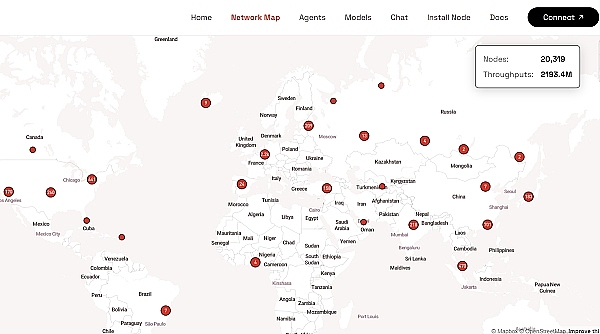
V. List of other early projects
Zotto: Users can create their own AI Agent to realize transaction intentions. Application scenarios include mirroring smart money addresses, multi-condition trigger transactions, etc. It has just been launched on Testnet, so you can pay close attention to it.
AgentLayer: Layer2 built on OP Stack, with AI Agent as the main narrative, wants to promote the connection between AI Agents developed by itself and the community.
Olas Network: An off-chain AI Agent ecosystem, where a single agent or multiple agents off-chain work together to complete tasks and pass the output to the chain.
Theoriq: Theoriq aims to become a modular and composable AI Agent base layer.
AgentCoin: Transformed from a mature AI Agent product evo ninja in Web2, it is a general-purpose Web3 AI Agent.
Giza: Working on a Web3 AI Agent framework, using ZKML off-chain reasoning and on-chain execution.
Olas Network: A Web3 AI Agent ecosystem, where a single Agent or multiple Agents work together off-chain to complete tasks proposed by users and pass the output to the chain.
 JinseFinance
JinseFinance











